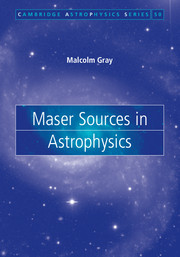Book contents
- Frontmatter
- Contents
- Preface
- 1 Introduction
- 2 Discovery
- 3 Basic theory
- 4 Observations of masers
- 5 Maser molecules
- 6 Environments of masers
- 7 Advanced theory
- 8 Computer modelling
- 9 Masers as diagnostics
- 10 Future prospects
- Appendix A Boltzmann's formula
- Appendix B Vector identities
- Appendix C Dirac delta-function
- Appendix D Change of variables in integration
- Appendix E Coordinate systems
- Appendix F Lagrange inversion theorem
- Appendix G Local standard of rest
- Appendix H Stochastic processes
- Appendix I Fourier transforms
- Appendix J Matrices
- Appendix K The centre of mass frame
- Appendix L Quantum-mechanical operators
- References
- Index
7 - Advanced theory
Published online by Cambridge University Press: 05 May 2012
- Frontmatter
- Contents
- Preface
- 1 Introduction
- 2 Discovery
- 3 Basic theory
- 4 Observations of masers
- 5 Maser molecules
- 6 Environments of masers
- 7 Advanced theory
- 8 Computer modelling
- 9 Masers as diagnostics
- 10 Future prospects
- Appendix A Boltzmann's formula
- Appendix B Vector identities
- Appendix C Dirac delta-function
- Appendix D Change of variables in integration
- Appendix E Coordinate systems
- Appendix F Lagrange inversion theorem
- Appendix G Local standard of rest
- Appendix H Stochastic processes
- Appendix I Fourier transforms
- Appendix J Matrices
- Appendix K The centre of mass frame
- Appendix L Quantum-mechanical operators
- References
- Index
Summary
This chapter deals with the theory of astrophysical masers in some depth. It therefore contains considerable mathematical detail, and is the most fundamental chapter from the point of view of maser physics. Perhaps the most important point to make is that maser radiation behaves, in its interaction with matter, in a way which is in principle different from the behaviour of ‘ordinary’ radiation. This difference arises from the generation of the maser radiation through the stimulated, rather than spontaneous, emission process.
Introduction to semi-classical theory
The interaction of radiation with matter can be treated via a hierarchy of approximations. At each level of approximation, accuracy of the representation is traded for simpler analysis and greater ease of use. Choosing the level of approximation which provides the minimum level of accuracy for a particular situation is often non-trivial, and the various approximations available are detailed in, for example, Sargent et al. (1974).
The most accurate representation of radiation interacting with matter is the fully quantum-mechanical model, in which an ensemble of active molecules, together with a radiation field of a countable number of photons, forms a combined quantum state. In this representation, the gain of one photon by stimulated emission is accompanied by the loss of one molecule from the maser transition upper level, and the increase in the number of such molecules in the lower level, with a resulting state change.
- Type
- Chapter
- Information
- Maser Sources in Astrophysics , pp. 241 - 293Publisher: Cambridge University PressPrint publication year: 2012

